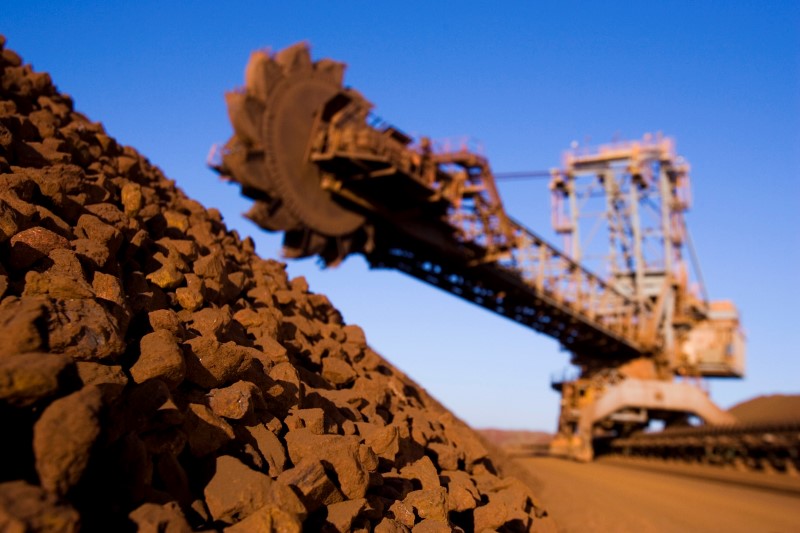(Repeats with no changes to text. The opinions expressed here are those of the author, a columnist for Reuters.)
By Clyde Russell
LAUNCESTON, Australia, Aug 1 (Reuters) - China's surging steel sector is pulling iron ore along for the ride, but the strong gain in prices raises the risk that marginal supply of the raw material will start to flow into what is already a well-supplied market.
Steel prices in Shanghai received another boost on Monday on the back of an increase in China's Purchasing Managers' Index (PMI) for the sector, which climbed to 54.9 in July from 54.1 in June, marking the third consecutive month that the indicator was above the 50-level that demarcates expansion from contraction. steel PMI was also at its highest in 14 months, which helped boost benchmark Shanghai steel rebar futures SRBcv1 to a close of 3,663 yuan ($545) a tonne, taking the year-to-date increase to almost 38 percent.
Strong demand for steel on the back of increased spending on infrastructure and housing construction have prompted China's mills to ramp up output to record monthly levels.
The positive steel story has ensured that iron ore has come along for the ride, with the spot price .IO62-CNI=MB jumping 7.2 percent on Monday to end at $73.70 a tonne.
The steel-making ingredient has surged 38.1 percent since the low so far this year of $53.36 a tonne, reached on June 13.
China's domestic iron ore futures on the Dalian Commodity Exchange DCIOcv1 have also enjoyed strong gains, ending at 554.5 yuan a tonne on Monday, up 32 percent since the recent low of 420.5 yuan on June 14.
It's definitely possible to make a solid case as to why iron ore has ridden on the coattails of steel, starting with the historically strong correlation between the two.
The robust profitability of China's steel makers, with ANZ Bank estimating they are making a record $741 a tonne currently, has driven stronger imports of iron ore, and consequently higher prices.
But the rise in price is likely to result in a return to viability for iron ore mines that would not be profitable at prices closer to $50 a tonne, both inside and outside China.
While not all of this supply can be ramped up quickly, some can and there is evidence to suggest that this already starting to happen.
China's iron ore imports were up 9.3 percent at 539.3 million tonnes in the first six months of the year compared to the same period in 2016, according to official figures. imports from the main suppliers were not up by as much as the overall gain, with Australia rising 8.2 percent, Brazil 7.3 percent and South Africa just 2 percent.
MARGINAL TONNES RETURNING
Instead, much of the rise in imports by China came from non-traditional markets such as India, which was up a massive 151.5 percent, Iran with a 56-percent gain and Sierra Leone with a jump of 115.2 percent.
If iron ore's rally continues, it's likely that miners in those countries will look to produce more and ship it to China.
An executive from an Indian iron ore mining company told Reuters at a recent industry event that his company can export to China at any price above $70 a tonne, and if it reaches $80 they would "aggressively" pursue volumes.
The official, speaking on condition of anonymity as he wasn't authorised to talk to the media, said his company had delivered some cargoes to China in the first quarter, but had stopped when prices fell toward $50 a tonne.
But with prices above $70, his company can get back in the export game.
China's own mines also appear to be ramping up production, with output rising 5 percent in June from a year earlier to a 20-month high of 124.7 million tonnes, according to official figures. worth noting that output was climbing even before the strong rally in prices that started only in mid-June, raising the risk that supply will increase at an even faster pace in coming months.
The other issue for iron ore is that supply from the last of the mega-mines developed over the last decade is likely to reach the market in the next few months.
The world's largest iron ore miner, Brazil's Vale VALE5.SA , is in the process of ramping up output at its 90-million tonne a year S11D operation, while top exporter Australia will add tonnes to the market as the 55-million tonne a year Roy Hill mine reaches full capacity.
The addition of millions of new tonnes from Brazil and Australia, the return of marginal tonnes from minor producers, and the increase in China's domestic output should serve to put the brakes on iron ore's rally, even if steel continues to perform strongly.
However, it can still take several months for this to occur, meaning iron ore can stay at the steel party for now.
<^^^^^^^^^^^^^^^^^^^^^^^^^^^^^^^^^^^^^^^^^^^^^^^^^^^^^^^^^^^ GRAPHIC: China iron ore futures vs steel futures
http://reut.rs/2hi9MPZ
^^^^^^^^^^^^^^^^^^^^^^^^^^^^^^^^^^^^^^^^^^^^^^^^^^^^^^^^^^^> (Editing by Joseph Radford)
